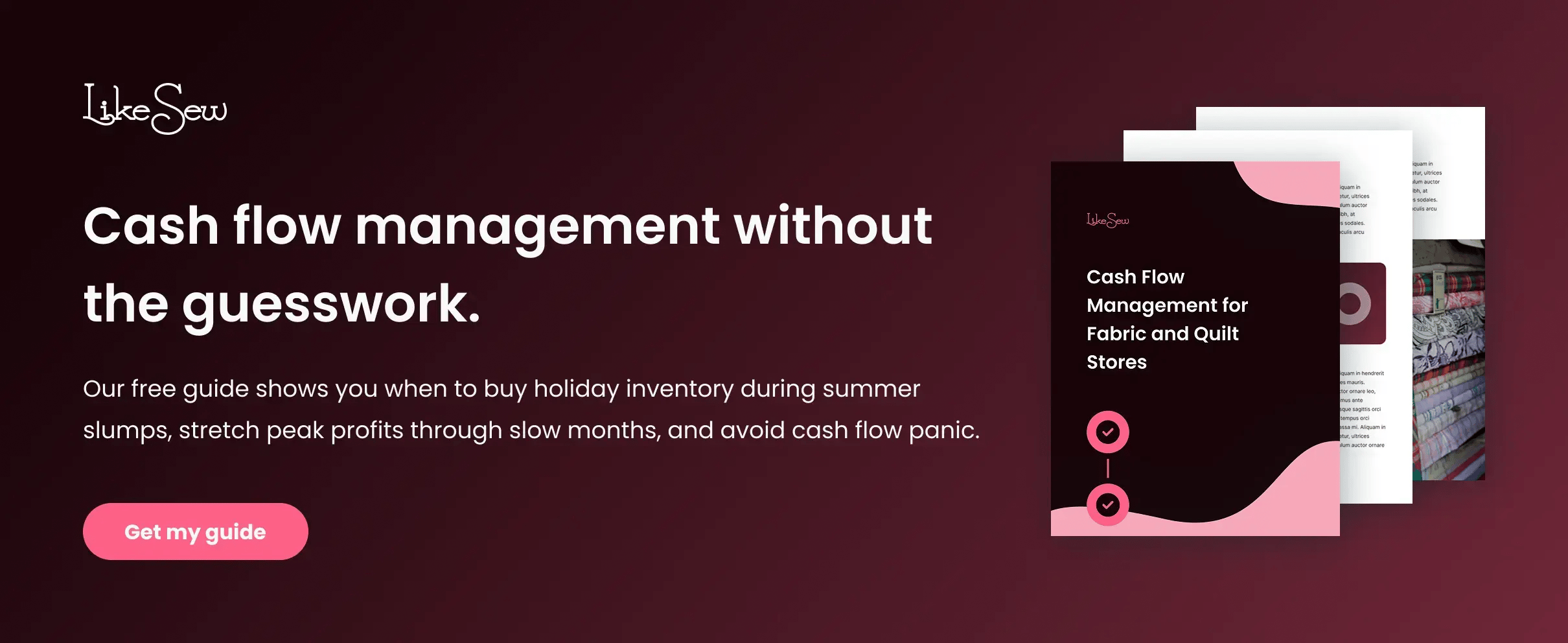
You’ve been quilting for years — maybe decades — and have always dreamed of opening up your own quilt shop.
Then, you sit down to crunch the numbers.
Opening a quilt shop is about chasing your passion for quilting, sure, but it’s also a sizeable financial undertaking. If you want your quilt shop to have the chance to become a thriving business, you need to understand the full financial picture upfront.
This post will cover the ins and outs of quilt shop startup costs. We’ll discuss all the expenses associated with fabric retail, providing you with the information you need to budget for your new quilting and fabric business.
Understanding Quilt Shop Startup Costs: What Makes This Business Unique
| Expense Category | Estimated Cost Range | % of Total Budget | Key Notes / Insights |
|---|---|---|---|
| Storefront Lease & Utilities | $2,500–$5,000 /month | 25–35% | Rent varies by size and location. Quilt shops need wide aisles, good lighting, and ground-floor access. |
| Initial Fabric Inventory | $15,000–$50,000 | 35–45% | Largest upfront expense. Include bolts, precuts, and seasonal fabrics. Avoid overstocking holiday prints. |
| Fixtures & Equipment | $5,000–$15,000 | 10–15% | Cutting tables, shelving, and storage. Quality fixtures improve workflow and presentation. |
| Point of Sale (POS) System | $1,000–$5,000 | 5–10% | Choose a fabric-specific POS that supports fractional yardage, vendor catalogs, and real-time inventory. |
| Renovation & Build-Out | $10,000–$20,000 | 10–15% | Includes painting, flooring, lighting, signage, and layout customization for customer flow. |
| Staffing & Training | $2,500–$5,000 /month per employee | 10–20% (ongoing) | Hire quilters who can advise on yardage and pattern planning. Budget time for POS and inventory training. |
| Hidden & Overlooked Costs | $2,000–$5,000 /year | 3–5% | Fabric waste, climate control, insurance for flammable inventory, vendor minimums, and seasonal part-time help. |
Opening a quilt shop isn't like opening just any retail store, and your startup budget shouldn't look like one either.
There are some standard retail expenses you’ll need to plan for, like rent and insurance, but the unique nature of your inventory means you’ll need to budget for specialized equipment and maintenance costs that most small business guides won’t mention. To mention a few:
- Inventory display needs: Your inventory is stored on bolts that require specialized display systems and occupy more space per dollar of product than most other retail categories.
- Seasonal cash flow: Inventory and sales don’t follow a predictable pattern in quilting retail — they swing dramatically based on the quilting calendar, with major buying seasons in the spring and fall, and slower summer months.
- Specialized equipment: You’ll need space for cutting tables, climate control to preserve delicate fabrics, and point of sale (POS) solutions that can track fractional yardage.
And these unique challenges are just the beginning. If you’ve read guides on how to plan for startup costs for a new retail store before, chances are you’re missing several key pieces of the puzzle for a quilt store.
This post will break down the real numbers, giving you all the details you need to set your new quilt shop up for success from day one.
Location Costs
One of the most significant upfront and ongoing costs of opening a quilt shop is your location. Your storefront lease will vary depending on your location and store size, but most quilt shops spend between $2,500 and $5,000 per month on their storefront.
The trick here is that square footage is a more significant consideration for quilt stores than other types of retailers. You’ll need to consider both vertical and horizontal space when planning your store layout.
Bolts of fabric displayed vertically eat up space fast. Plus, you’ll need room for customers to pull bolts from the shelf, unroll several yards to see the pattern repeat, and compare fabrics side by side. All of this adds up to the need for wider aisles than those found in a typical retail store.
You’ll also need to invest in a space with enough room for a dedicated cutting table area. This space will need to be large enough for staff to measure, cut, and package fabric orders. An average cutting table is 10 to 20 feet long, so plan for a space at least that large.
But you’ll need to consider more than the space itself when choosing your storefront. Be sure to invest in a space with adequate parking and ground-level or elevator access to make it easier for quilters to wheel larger fabric orders out of your store.
Related Read: Retail Customer Experience 101: 8 Best Practices for Fabric Shops
Inventory Investment
Your initial fabric inventory will be your largest upfront investment. Plan to spend anywhere from $15,000 to $50,000 on this initial fabric order. The range is broad, and where you’ll fall within that depends on your store size and the variety of products you intend to carry.
There are a few challenges to fabric inventory you need to keep in mind:
- Bolts are expensive: A single bolt of quality quilting cotton runs between $100 and $150 wholesale, and you need variety to attract customers, meaning you’ll need to take a risk and invest in those expensive bolts upfront.
- Precuts and kits are essential: Fat quarters, charm packs, jelly rolls, and kits offer faster turnover and higher margins than bolt fabric alone, so be sure to stock these as well.
- Consider seasonal buying: You’ll need holiday and seasonal fabrics for each holiday and season to sell to seasonal crafters, but be careful not to overstock on items that won’t sell once the holiday season passes.
Your quilt shop inventory investment is all about timing your purchases strategically so you have the right fabrics available when customers want them, without tying up so much capital that you can't cover your other expenses during slower months.
Related Read: Manage Your Sewing Business Inventory: 7 Best Practices
Specialized Equipment and Fixtures for Fabric Retail
Running a fabric store requires specialized equipment. Budget $5,000 to $15,000 for fabric store equipment, shelving, and display systems. Here’s a breakdown of some of the specialized equipment you need to consider.
- Fabric cutting tables: $1,500 to $4,000
- Rotary cutters, rulers, and measuring tools: $500 to $1,500 total
- Inventory storage and organization systems: $1,000 to $4,000
- Backstock storage solutions: $1,000 to $3,000
These pieces are the foundation of your store’s operations. This upfront cost can feel overwhelming, but when you invest in quality equipment from the start, you’ll find it pays for itself by making operations smoother.
Point of Sale System
Every retail store needs a point of sale system, but fabric stores have specialized needs that require a specialized POS solution.
When you’re already cash-strapped from your earlier investments, it can be tempting to choose the cheapest solution on the market, but if you want to run a profitable shop, you need specialized features:
- Fractional yardage tracking so you can track your inventory down to the inch.
- Real-time inventory management for better visibility into your sales and inventory.
- Vendor catalog integration for automatic price updates.
- Cash flow reporting to help you track the swings between peak quilting seasons and summer slumps.
The right POS system is an investment that helps prevent the expensive mistakes that drain your budget. When you can see your inventory in real-time, track fractional yardage accurately, and understand your cash flow patterns, you make better decisions for your business.
See the exact cost of your ideal point of sale solution with our transparent pricing tool.
Renovation and Store Setup Costs
Even if you find the perfect retail space, chances are you’ll need to invest some cash upfront on basic build-out. You’ll need to consider painting the space, updating your flooring, and creating a layout that works well for both your store and customers.
Depending on the size of your store and the amount of work your space requires, you may need to budget for costs ranging from $10,000 to $20,000.
Related Read: The Best Quilt Shop Floor Plan: Help Customers Find What They Need
Next, you’ll need to invest in proper lighting. Quilters need to see accurate colors, which means you need quality lighting throughout your space. Poor lighting makes your store less appealing and leads to returns when customers get home with their purchases, only to see that the color looks different in sunlight.
Plan to spend between $1,000 and $3,000 updating and installing lighting in your store.
If you plan to offer classes or host block-of-the-month gatherings, you'll also need to install a workshop area. Invest in comfortable seating and adequate table space.
Staffing Costs
If you’re hiring staff, you’ll want to budget for the ongoing cost of employee wages. Depending on your location and your staff’s experience level, you’ll want to plan to spend between $2,500 and $5,000 per month per employee.
This cost may seem steep, but unlike generic retailers who can hire anyone with a customer service background, you’ll need your staff to understand quilting and fabric. A staff member who can help customers calculate yardage for a quilt pattern, suggest coordinating fabrics, or troubleshoot a project issue is worth the higher wage you’ll pay them.
Don’t forget the cost of training, as well. You’ll need to invest time and money in teaching new staff your systems, processes, and product line. Even experienced quilters need to learn your inventory organization, your POS system, and your specific policies.
Note: During peak seasons (typically spring and fall), you might need additional part-time help. Be sure to plan for this cost upfront, especially if you’re opening up shop during one of these peak seasons.
Hidden Costs That Catch New Owners Off Guard
We’ve covered the major expenses — rent, inventory, fixtures — but fabric retail involves some hidden costs you might not see coming.
Here are the hidden expenses that fabric store owners wish they'd known about from day one:
- Fabric waste from cutting errors and sampling: Plan for $500 to $1,000 annually in fabric that never gets sold due to miscuts, sample making for displays, and class demonstrations.
- Climate control: Your utility bills will run higher than typical retail because you're protecting inventory from humidity, heat, and sunlight damage.
- Insurance specific to fabric inventory value: Insuring large quantities of flammable material costs $800 to $3,500 annually, depending on your inventory value.
- Vendor minimum orders: Many fabric suppliers require a minimum purchase of $500 to $1,000 per order, forcing you to buy more than you immediately need just to access certain collections.
Keep these hidden costs in mind so you aren’t surprised by unexpected expenses six months into running your dream store.
Smart Financial Planning for Your Quilt Shop Startup
What does opening a quilt shop cost? You’ll need to budget between $50,000 and $150,000+, depending on your location, store size, and the variety of inventory you plan to carry.
The quilt shops that thrive succeed because they bring more than passion and product knowledge to the table. Owners who plan for seasonal swings, budget for the financial nuances of fabric retail, and invest in the right tools from day one are more likely to succeed.
One of the most important tools in your toolkit is your point of sale solution. Plan for your startup costs and budget appropriately by building and pricing out your ideal LikeSew point of sale solution today.
Get your customized price and see how the right POS system pays for itself by keeping your store running smoothly.


 by
by 







